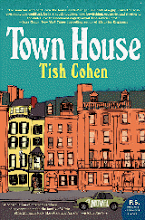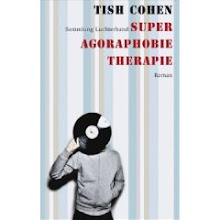Wednesday, June 4, 2008
Great heaps of rumpled, clean laundry the sign of a healthy mind
It's also at this stage Mummy realizes--with some guilt, but not nearly enough--that her children are heading off to school with t-shirts so wrinkled other kids may go home and report it to their parents. Which means other parents will think that things are somewhat out of control at the Cohen house.
Okay, maybe they are--if you consider fresh laundry and clean dishes and a fully stocked fridge to be a sign of mental stability. In our house, however, we're more than willing to forage for food and the least rumpled shirt if it means we can spend more time together writing, reading, making music, drawing, laughing...whatever. And if the mountain of clothes at the end of my bed waiting to be folded and put away is any indicator of our collective mental health, we're doing great.
What about you? What odd signs of happiness does your house reveal?
Friday, May 30, 2008
Families in the Fast Lane by guest blogger Jennifer Kolari, MSW, RSW
In addition to soccer practice, swimming or music lessons, tutoring and Karate, our home life can be filled with video games, iPods, Blackberrys and computers, all of which can make it even more difficult for families to stay close and connected. This added stress can raise frustration levels, causing us all to be short or impatient and further disconnected from one another.
All the stress of rushing and driving from program to program can wear on us. If it were as easy as just cutting back on these programs it would be a simple fix, but for many, this is the way life works and their kids want to be involved in these activities.
It is important to make sure that the benefits of the program outweigh the stress it puts on all of us. And that we consider the importance of relaxed family time, walks, board games and unstructured play time when planning our weeks. When we were young there were always kids out on the street ready to play kick the can or hide and seek, today most streets are empty with kids in organized programs. While I worry about the lack of free unorganized play and children needing time to chase butterflies and lie in the grass I do realize that the reality is -- there often is no one on the street to play with. Play dates are booked and carefully scheduled around lessons and activities. It will take a collective effort for all of us to see the value in play and downtime. Below are some tips to help busy families deal with this issue.
-Take a family inventory of activities; work towards balance for everyone not just the kids.
-Have your child involved in one non-negotiable activity. Other activities they can choose, try, and not necessarily stick with.
-Cut back on activites by allowing just one activity per term, and another they would really like to do later in the year.
-Build in time for unstructured play.
-Build in for transition times like leaving the house or moving from one activity to another to reduce stress.
-Schedule in time with your children, put them in your day timer, they will love seeing their names there.
-Turn computer, blackberry, cell phones off for set amounts of time.
-Try, when possible, to eat dinner together.
-Make time to be silly to ensure you are laughing and having fun.
-Sit with them for a few minutes when they are watching TV or playing a video game.
-Take your child or teen to lunch, have a set time once a month.
-Use time in the car to talk, kids often say more in the car.
-Build in time to relax, play games, go for walks, don’t just talk about it.
Wednesday, May 21, 2008
High Praise for Inside Out Girl from author Jacquelyn Mitchard
Jacquelyn Mitchard, New York Times bestselling author The Deep End of The Ocean and Cage of Stars
Tuesday, May 13, 2008
Giving Children's Anxiety a Name, Face, even Toenails!
I was told to come up with an image of what my anxiety looked like - short or tall, what color, etc. What I came up with was a tangle of purplish-brown hairy lines with cartoon eyes, hands, and feet. Right away, my own creature was sort of cute in an annoying way. He only came up to my knees, so I was the one in power. But the greatest thing about creating a separate persona for my fear was that it then existed outside of me--no longer within. It wasn't a part of me, it was a little being I could order away from me if need be.
For example, if I was going to a reading and was nervous, I could imagine this hairy beast, tell him he was not allowed to follow me (bookstores tend to frown upon purple hairballs hanging around, don't they?). My therapist said to give him (see - already he has a gender, ha!) one spot in the house where he was allowed to exist and banish him to his spot when you want to get rid of him.
So if your child is experiencing anxiety, ask her what her anxiety looks like - if it could look like anything in the world. Let her create this creature in great detail and laugh over little parts of it--the ragged ears or yellow teeth. Then have her name it, decide how large or small it is. Let her discuss it's odd habits, then pick the spot where it's allowed to live. Your child will have so much more power over her anxiety, you should see an improvement right away. And as she banishes her little creature to its spot more and more, the creature's strength will gradually begin to fade, leaving your child free from its ugly cracked toenails more and more.
I'd love to hear if it works for anyone - even if you try it for yourself!
Sunday, May 11, 2008
Managing Anxiety in Children by Family Therapist Jennifer Kolari, MSW, RSW
We are all born hardwired for how we handle anxiety, some of us are not anxious at all – some of us are very anxious. In addition to that hard-wiring, life events and experiences push us up or down the continuum. Some anxiety is good safe choices but we want to make sure that our children control their anxiety so it doesn’t control them. We don’t want their worries and fears to get in the way of enjoying and participating fully in their lives.
The best way to determine if your child has a problem with anxiety is to think about whether it is stopping them from doing the things they want to. Does it make them feel badly about themselves? Do they spend a lot of time clinging and crying or if they’re older withdrawing. Do they feel great distress when separating from you? Do they worry way in advance about things that have not happened yet? Do they constantly complain of headaches, stomach aches or dizziness? Any physical symptoms should be checked out by a doctor but you can ask your child’s pediatrician to investigate anxiety if this is a theme for your child.
Parents should also understand that some children are happy even though they tend to stand on the sidelines. It is not always anxiety some children prefer to observe and take things in tackling tasks or activities when they are ready. It’s important to know when it’s our issue versus theirs.
Children don’t always show the typical or obvious signs of anxiety that we might think of, sometimes demanding behavior, extreme bossiness temper tantrums and sleep disturbances can all be symptoms of anxiety.
Here’s what to do:
Get Connected: Spend more cuddle time with young children and spend more alone time with teenagers. Children feel safe and more secure when they feel deeply loved.
Fight or Flight Response: When a child is feeling anxious, their fight or flight instincts might kick in. This means their brain is not letting them think rationally, so when a parent tries to rationalize the situation, the child feels like they aren’t being listened to. Instead, ask lots of questions about how they are feeling, and put some urgency in your voice, without sounding anxious yourself. This will show you get that they are worried, and will help them get back to a place where they can hear the logical things you have to say.
Give it a Name: Don’t talk about your child being afraid, because this makes it seem like something that they can’t fix. Give it a name, like the “worry bug” for older kids or teens just refer to it as the worry that gets in the way. Then you can work together to come up with ways to reduce it. This helps kids to control their emotions.
Get the Control back: Kids are exposed to a lot of adults themes – and they are not socially or emotionally prepared to deal with these. Set limits on behavior and the things you kids are exposed to. When kids see that parents don’t have control they get nervous about who will take care of them, this aggravates anxiety.
Scaling: Get your kids to rate their anxiety and use deep breathing or positive imagery to bring the number down.
Calm yourself: Sometimes children come by there anxiety honestly. Use the same techniques to make sure you are calm. Kids often gauge their responses based on ours.
Jennifer Kolari, MSW, RSW
www.connectedparenting.ca
Sunday, April 27, 2008
Why write a novel about NLD?

Non-verbal learning disorder or NLD is a particularly poignant condition. Often misdiagnosed as Asperger’s Syndrome (high-functioning autism) or Savant Syndrome (a developmental handicap accompanied by extraordinary mental abilities in one or more fields), children with NLD typically excel in early speech and vocabulary development, and display a remarkable memory for things that interest them. Like the Aspie child, Olivia Bean in INSIDE OUT GIRL is capable of discussing the elimination habits of the Norway rat long after you’ve thrown out the dinner you no longer have the desire to eat!
Just like Aspie’s, kids with NLD tend to fall short with social, motor and visual-spatial skills. The subtlety of language eludes them. The subtlety of social innuendo eludes them. They tend to be the kids in 7th grade who show up wearing sweatpants pulled up to their armpits and the musty woolen liners of their winter boots—social suicide in middle grade. The other kids often pick on them and they can fall prey to relentless bullying.
And here lies the poignancy of NLD. Aspies tend to exist within their own isolated social bubble, uninterested in connecting with other children. Not so with the NLDer. The child with NLD—so sweet and naïve—typically wants to be loved, wants to be accepted. Every snub in the playground wounds them to the core. Olivia Bean longs for her birthday party so she can invite everyone from her class. But her father knows no matter how many invitations his daughter doles out, not a single child will show up. The NLD child wants social acceptance more than anything, and more often than not will never achieve it.
Just imagine your own child going through this.
Anxiety Disorder, Agoraphobia, NLD - All the Lonely People

Some of you might have seen Town House, my debut novel about the agoraphobic son of a rockstar who is too crippled by panic attacks to leave his Boston town house. Because I seem to be obsessed with the human condition, particularly any condition that causes a person to view the world through eccentric-colored glasses, much of my writing centers around people with disorders of some sort. People who, because of their conditions, might feel alienated, as if real life is happening at a different speed, at a different frequency. I like to think of them as the Eleanor Rigbys of the world. I should know, I'm one of the lonely people myself, having battled anxiety, panic attacks and on-again off-again agoraphobia most of my adult life.
So...my next novel, titled Inside Out Girl, comes out August 12, 2008, and features a learning-disabled ten-year-old who is constantly bullied. Olivia Bean has a non-verbal learning disorder (NLD), a condition often confused with Asperger's Syndrome.
Synopsis from the back cover:
Rachel Berman wants everything to be perfect. As an overprotective, single mother of two, she is acutely aware of the statistical dangers lurking around every corner--which makes her snap decision to aid a stranded motorist wholly uncharacteristic. Leonard Bean is broken down on the highway with Olivia, his rodent-obsessed, relentlessly curious, learning disabled 10-year-old daughter. To the chagrin of Rachel’s children, who are about to be linked to the most mocked girl in school, Rachel and Len begin dating. And when her father receives terrible news, little Olivia needs a hero more than ever.
But the world refuses to be predictable. When personal crisis profoundly alters Rachel’s relationship with a very wild, very special little girl, this perfectionist mother finds herself drawn into a mystery from her past and toward a new appreciation for her own children’s imperfect lives. INSIDE OUT GIRL (Harper Perennial, August 2008) shows that no matter how much our world can crumble around us, it is our strength that defines us. The challenges we face only enrich our lives and teach us lessons that will last a lifetime.



